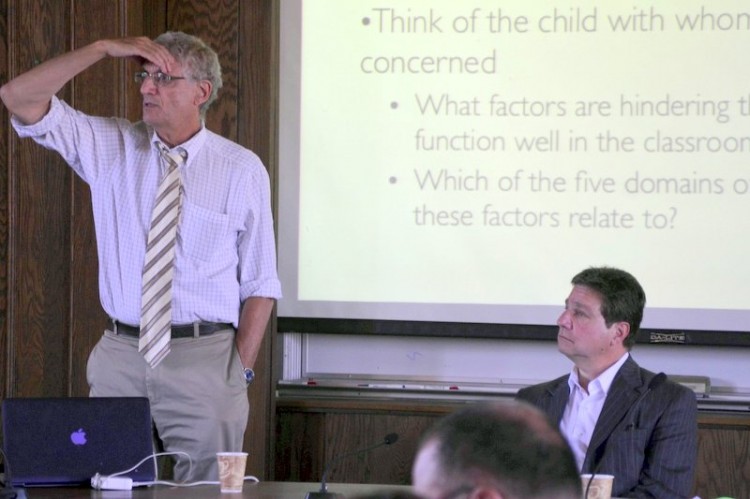When Stuart Shanker began using his psychology training to help reduce stress in Canadian classrooms, he never imagined that in a few short years his concept would be adopted widely—not just across the country but around the world.
Shanker is a professor of philosophy and psychology at York University in Ontario and a leading expert in neuroeducation.
His revolutionary “self-regulation” method guides kids to recognize, evaluate, and manage their emotions in order to remain calm, focused, and alert—the optimal state for learning.
The tools to teach self-regulation, which are many and varied but can include exercise, quiet meditation, or use of a “fidget toy,” are designed to help children recognize their own feelings on a deeper level and use this understanding to manage negative emotions while increasing positive ones.
“Self-regulation is designed to reframe a child’s behaviour, that’s the key to it,” says Shanker.
“If a child is having trouble paying attention, is very impulsive, easily distracted, highly withdrawn, or extremely anxious, then, rather than trying to essentially force the child to behave the way in which we want, using punishment and reward which doesn’t work very well, instead we seek to help the child self-regulate.”
Behaviours such as impulsivity, poor attention, and anxiety, he notes, are symptoms of stress, a problem that has been increasing in classrooms, not just among students but also for teachers.
Growing Popularity
Shanker’s work to help children manage stress seems to have resonated with the education community, and teachers have been reporting success with the framework.
Starting with programs in three Surrey, B.C., schools in 2008, self-regulation is being used in public schools across B.C., Ontario, PEI, and is soon to be adopted in the Yukon, Saskatchewan, and the Northwest Territories.
Pilot programs have also started in New Zealand, Eastern Europe, Ireland, Mexico, and Columbia.
Similar programs have been popping up across the U.S. in recent years, including MindUP, a system founded by actress Goldie Hawn and promoted through the Hawn Foundation.
The trend may indicate the need for more effective ways to help children deal with emotional problems, a phenomenon on the rise.
According to a federal government report titled, “The Wellbeing of Canada’s Young Children,” the incidence of mental health issues among children is predicted to increase by 50 percent by the year 2020.
Child Stress on the Rise
Increased stress levels in children has been attributed to everything from increasing urbanization and a lack of nature-based experiences, to the decline in exercise, poor eating habits, over-scheduling, family breakups, and exposure to violent or disturbing themes in the media.
Shanker knows these stats all too well, and was given $10 million to fund and staff the Milton and Ethel Harris Research Initiative at York University, an institute that looks for solutions by studying processes that promote the development of healthy minds in young children.
“Our data tells us that something is happening with our children, and we'd better do something about it,” he says.
According to Shanker, the primary sources of stress or challenge in a child’s life are found in “five domains”—biological, emotional, cognitive, social, and pro-social—which self-regulation works to address simultaneously.
To reduce the amount of stress or over-stimulation, he recommends first reducing the amount of external stressors in a child’s environment and then teaching them to regulate their internal stressors.
Through self-regulation, kids can then recognize when they start to become anxious or overwhelmed, and find ways to regain a sense of calm.
In the classroom, stressors can be mitigated with something as simple as reducing background noise levels or creating a quiet library at the back of the room where children can go when they feel overwhelmed.
Free Webinars, Consultations
Along with his team, Shanker offers free webinars and consultations for schools interested in developing self-regulation programs, and says he could never have anticipated the high demand.
“At this time it’s spreading faster than we can deal with,” he says.
Though the programs vary, the self-regulation framework has become a “grassroots phenomenon,” he adds, because it is spreading primarily through word of mouth, and schools are learning how to improve techniques through their own experiences, while sharing successes.
“It’s a movement, and it’s one where everybody’s kind of learning together, and coming up with ideas together, and I think what it means is that within a very short time what we’re going to see is that we will have effective techniques, not only for helping all maximize their learning potential, but it’s having an extraordinary effect at reducing teacher’s stress, and teacher stress is very high in Canada right now.” Shanker says.
“I just think there’s just this natural understanding in the country that if it’s for our children, we don’t make money off this. We do this, and we’re going to learn from each other and make it as good as we can.”
Shanker just released a book on the framework, titled “Calm, Alert, and Learning: Classroom Strategies for Self-Regulation.”
The Epoch Times publishes in 35 countries and in 19 languages. Subscribe to our e-newsletter.





